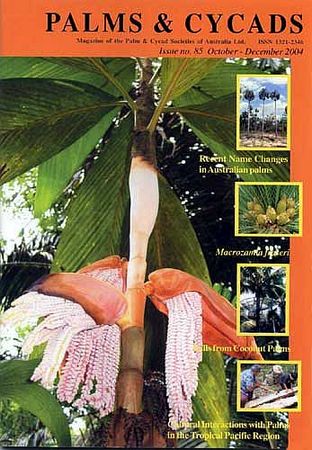Pinanga chaiana
| Pinanga (pih-NAHN-gah) chaiana (kah-ee-AHN-ah) | |||||||
|---|---|---|---|---|---|---|---|
 Photo by Mike Edwards | |||||||
| Scientific Classification | |||||||
| |||||||
| Synonyms | |||||||
|
| |||||||
| Native Continent | |||||||
|
| |||||||
| Morphology | |||||||
| |||||||
| Culture | |||||||
|
| |||||||
| Survivability index | |||||||
|
| |||||||
| Common names | |||||||
|
| |||||||
Contents
Habitat and Distribution
Borneo.Description
Solitary, unarmed, pleonanthic, monoecious undergrowth palm. Stem erect, unbranched, up to 5.5 m tall, about 2.5 cm in diam., with internodes to 5 cm; nodes only slightly prominent; stem surface dull greenish-brown, densely covered with pale brown flocculent indumentum. Crownshaft elongate, about 40 cm long, only slightly wider than the stem, about 3.5 cm in diam., dull green but densely covered with abundant flocculent pale buff to bright reddish-brown indumentum; ligule poorly developed; about 7 leaves in crown. Whole leaf including leaf sheath to 1.8 m long; leaf sheath to 30 cm long; petiole to 18 cm x 7 mm, triangular in cross-section; lamina entire except for a deep apical split, to 130 cm long, 38 cm wide at the widest point near the leaf tip, coarsely and shortly toothed at the apex, the toothed edge about 17 cm long, the lamina shallowly folded with about 32 main adaxial ribs, with a few less prominent parallel ribs between these; lamina when fresh pale dull green, slightly paler on lower surface than on upper, on drying becoming dull green on upper surface and russet brown on lower surface; brown indumentum very sparse, scattered along main veins on abaxial surface. Inflorescence infrafoliar, pendulous, to about 18 cm long; prophyll not known; all other parts turning black on drying; peduncle erect at base, then sharply reflexed, about 2 cm x 7 mm, with 5-7 crowded parallel branches; rachillae to 20 cm x 2 mm, glabrous; triads borne strictly distichously, about 4 mm apart; staminate flowers not known; pistillate flower globular, ± partly sunken into the rachilla; calyx of 3 free or basally shortly joined, rounded, cucullate, imbricate petals 1.2 mm in diam.; ovary rounded, about 1 mm in diam., tipped with an irregular umbonate stigma. Mature fruit not known; almost mature fruit greenish-yellow, spindle- shaped, 10 x 6 mm, terminating in a moderately sharp point. Seed 8 x 4 mm; endosperm deeply ruminate. (J. Dransfield. 1980)/Palmweb. Editing by edric.
Stems clustered or less often solitary, ringed with prominent leaf scars, tall to short or subterranean. Leaves 5-11, pinnate or occasionally undivided; leaf sheaths closed, forming a prominent, yellowish to reddish green crownshaft (rarely open and not forming crownshafts), usually covered with variously colored scales; pinnae regularly arranged along rachis, spreading in same plane, linear to sigmoid, 1- to several veined, at leaf apex pinnae joined with only a short split at tip, giving pinnae a lobed appearance. Inflorescences branched to 1 order, with a few rachillae, sometimes spicate, borne below crownshaft, rarely among leaves, covered initially with prophyll; rachillae becoming pendulous, seldom remaining erect, usually smooth, sometimes hairy; flowers unisexual, borne throughout in triads of 1 female flower flanked by 2 male flowers, these arranged distichously along rachillae, or less often tristichously or spirally. Fruits red, orange, or black, small, ellipsoid to globose or spindle-shaped, commonly beaked, 1-seeded, ripening through a series of colors, commonly from green to pink to red to black; endosperm ruminate, rarely homogeneous; germination adjacent; eophylls bifid. (efloras.org)
I observed it sterile in a habitat similar to that of the type, at the foot of G. Buda, in the proposed extension of the G. Mulu National Park in October 1977. This pinang is very distinctive in its russet brown crownshaft, undivided leaves, and branched inflorescence. In inflorescence structure it appears to approach P. patula Blume, but is vegetatively quite distinct. (J. Dransfield. 1980)/Palmweb.
Culture
Comments and Curiosities
Etymology: This handsome 'pinang' is named after Paul Chai, the Forest Botanist, Kuching, who collected the type, and whose enthusiasm for palms has done much to enrich our knowledge of Bornean palms. (J. Dransfield. 1980)/Palmweb.
"A small growing Pinanga with silvery green entire leaves from Borneo, a truly stunning species that is still very rare in cultivation today and is a must have for the true collector, best suited to the tropics but can be grown in a protected location in the subtropics in a frost-free area." (Clayton York, Utopia Palms & Cycads)
- IMAGE GALLERY
External Links
References
Phonetic spelling of Latin names by edric.
Special thanks to Geoff Stein, (Palmbob) for his hundreds of photos.
Special thanks to Palmweb.org, Dr. John Dransfield, Dr. Bill Baker & team, for their volumes of information and photos.
Glossary of Palm Terms; Based on the glossary in Dransfield, J., N.W. Uhl, C.B. Asmussen-Lange, W.J. Baker, M.M. Harley & C.E. Lewis. 2008. Genera Palmarum - Evolution and Classification of the Palms. Royal Botanic Gardens, Kew. All images copyright of the artists and photographers (see images for credits).
Dransfield, J. 1980. Systematic Notes on Pinanga (Palmae) in Borneo. Kew Bulletin, Vol. 34, No. 4, pp. 769-788.
Many Special Thanks to Ed Vaile for his long hours of tireless editing and numerous contributions.














